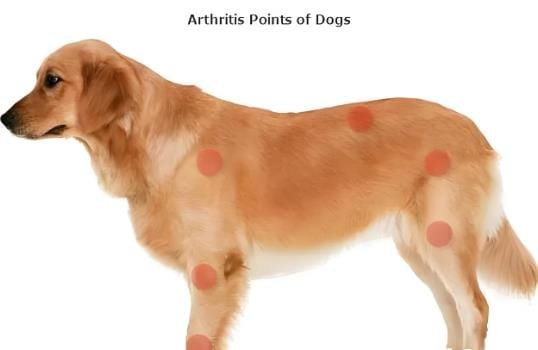
Massage Techniques for Arthritic Dogs: Pressure Point Maps
Helping Your Arthritic Pup Feel Better: Simple Massage Tips (and Where to Focus)
So, your furry buddy’s joints aren’t what they used to be? Arthritis can really take the spring out of a dog’s step. The good news? Gentle massage might help ease their stiffness and discomfort. Let’s talk about how to do this safely—no fancy degrees needed, just some patience and love.
First Things First: Keep It Chill
Dogs hate feeling forced into things. Start when your pup’s already relaxed—maybe after a walk or a nap. Sit beside them, speak softly, and let them sniff your hands. If they seem tense or pull away, try again later. Trust is key here!

Finding the “Sweet Spots”
While dogs don’t have exact “pressure point maps” like humans, certain areas tend to hold tension when joints ache. Focus on:
- Hips & Lower Back: Gently rub in small circles where their tail meets their body. This area often gets tight.
- Shoulders & Front Legs: Slide your fingers along the muscles above their front legs. Many dogs carry stress here.
- Behind the Knees: Use your thumb to lightly press the soft area behind their back legs. Go super slow—this spot’s sensitive!
How Much Pressure?
Think “barely there” touches at first. Imagine petting a sleepy kitten—that’s your pressure guide. As your dog relaxes, you might press slightly firmer, but stop immediately if they flinch, lick their lips, or tense up. Their body language will shout louder than any tutorial!
Timing Matters
Short sessions work best—aim for 5-10 minutes daily. Overdoing it could leave them sorer. Watch their mood: If they nudge your hand for more, great! If they wander off, respect that.

Extra Tips for Happy Joints
- Warmth helps! Try massaging near a heater or using a warm (not hot!) towel on stiff areas first.
- Pair massage with vet-approved pain relief or supplements for a bigger impact.
- Keep their weight in check—extra pounds strain those achy joints.
When to Hit Pause
Massage isn’t a magic fix. If your pup’s pain seems worse, they yelp when touched, or joints look swollen, call your vet ASAP. Better safe than sorry, right?
Final Thought
Every dog’s different. What soothes one might annoy another. Stay flexible, keep sessions upbeat, and celebrate small wins—like that tail wag when you hit just the right spot. Who knew your hands could be such powerful medicine?
Got a success story or a question? Share below! We’re all here to help our four-legged pals live their comfiest lives.
American Dingo animal behavior Budget Tips canine behavior Canine Care Canine Health DIY pet projects dog behavior Dog Breeds dog care Dog Care Tips dog exercise Dog Food Dog Grooming dog health Dog Measurement dog nutrition dog ownership dog potty area Dog Training Dog Wound Care Family Pets Hunting Dogs lipomas in dogs newborn puppy care obedience training outdoor pet care Pet Care Pet Care Tips Pet Health Pet Loss Pet Safety pet tips pet training Positive Reinforcement Potty Training Puppy Care puppy health Puppy Training Rabies in Dogs Temperature Monitoring Training Tips veterinary advice Veterinary Care Veterinary Tips
-
 Essential Care Guide: Pet dogs Wellness Checks Every Owner Needs
2 views
Essential Care Guide: Pet dogs Wellness Checks Every Owner Needs
2 views -
 Understanding Exercise Needs for Different Dog Breeds
2 views
Understanding Exercise Needs for Different Dog Breeds
2 views -
 2025 Mice-Proof Dog Food Storage: 3 Expert Tips to Block Rodents (+ Garage Storage Hacks)
2 views
2025 Mice-Proof Dog Food Storage: 3 Expert Tips to Block Rodents (+ Garage Storage Hacks)
2 views -
 How to Successfully Potty Train Your Dog in Singapore
1 view
How to Successfully Potty Train Your Dog in Singapore
1 view -
 How to Teach Your Puppy to Sit: A Step-by-Step Guide
1 view
How to Teach Your Puppy to Sit: A Step-by-Step Guide
1 view -
 The Ideal Age to Start Potty Training Your Dog
1 view
The Ideal Age to Start Potty Training Your Dog
1 view -
 Top 10 Famous Dogs in the World The Three Stooges of Sledding and Housebreaking Make the List
1 view
Top 10 Famous Dogs in the World The Three Stooges of Sledding and Housebreaking Make the List
1 view -
 Pitbull Allergies: 7 Vet-Approved Signs, Treatments & How to Protect Your Dog (2025 Guide)
1 view
Pitbull Allergies: 7 Vet-Approved Signs, Treatments & How to Protect Your Dog (2025 Guide)
1 view -
 Mastering the Art of Training a 2-Year-Old Dog: Tips and Tricks
1 view
Mastering the Art of Training a 2-Year-Old Dog: Tips and Tricks
1 view -
 2025 Dog Labor Guide: 4 Vet-Approved Steps for Safe Home Delivery (Emergency Protocols Inside)
1 view
2025 Dog Labor Guide: 4 Vet-Approved Steps for Safe Home Delivery (Emergency Protocols Inside)
1 view










Leave a Reply
You must be logged in to post a comment.